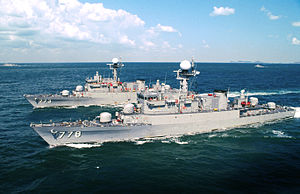Pohang-class corvette
This article needs additional citations for verification. (March 2008) |
 Pohang-class corvette
| |
| Class overview | |
|---|---|
| Name | Pohang class |
| Operators | |
| Preceded by | Template:Sclass- |
| Succeeded by | Template:Sclass- |
| In commission | 18 December 1984 - present |
| Completed | 24 |
| Active | 18 |
| Lost | 1 |
| Retired | 5 |
| Preserved | 1 |
| General characteristics | |
| Type | Corvette |
| Displacement | 1,200 tonnes (1,200 long tons; 1,300 short tons) |
| Length | 88.3 m (289 ft 8 in)[1] |
| Beam | 10 m (32 ft 10 in)[2] |
| Draft | 2.9 m (9 ft 6 in)[1] |
| Propulsion | CODOG unit[2] |
| Speed | |
| Range | 4,000 nautical miles (7,400 km)[2] |
| Crew | 95 |
| Sensors and processing systems |
|
| Electronic warfare & decoys |
|
| Armament |
|
The Pohang-class corvette (Korean: 포항급 초계함, Hanja: 浦項級哨戒艦) is a class of general purpose corvettes operated by the Republic of Korea Navy. They have served in a coastal defense role during the late Cold War and post Cold War period. A total of 24 Pohang-class vessels were built, all constructed in South Korea. 18 vessels remain in service.
History
Sinking of ROKS Cheonan
At 21:21:57 (12:21:57 UTC) of 26 March 2010, an explosion (or two explosions) occurred for 1~2 seconds at the stern of ROKS Cheonan, causing a power stoppage and inflow of oil and seawater, and the ship heeled 90 degrees to starboard very quickly. When the crew went out to the deck, they found the stern already submerged. At 22:40, the Navy and the Coast Guard rescued 58 sailors, including the captain, from the crew of 104; 46 were killed.[4] The ship sank around 01:00 on 27 March 2010.
The bow floated 6.4 kilometres (3.5 nmi) to the southeast from the explosion site, then submerged completely at 22:30 on 27 March 2010.
On 20 May 2010, a South Korean-led investigation group announced that all evidence pointed to a North Korean torpedo being responsible for the sinking of Cheonan.
Ships in the class
| Name | Number | Builder | Launched | Commissioned | Decommissioned | Status |
| Flight II | ||||||
|---|---|---|---|---|---|---|
| Pohang | PCC-756 | Korea Shipbuilding Corporation (now Hanjin Heavy Industries) |
30 June 1984 | 18 December 1984 | 30 June 2009 | Used as a museum ship in Pohang city |
| Gunsan | PCC-757 | Korea Takoma Shipyard (now Hanjin Heavy Industries) |
30 November 1984 | 29 September 2011 | Offered to the Colombian Navy but rejected in favor of the Template:Sclass- | |
| Gyeongju | PCC-758 | Hyundai Heavy Industries | 1 May 1985 | 30 December 2014 | Transferred to Peruvian Coast Guard as BAP Ferré[5] | |
| Mokpo | PCC-759 | Daewoo S&M Engineering | 17 May 1985 | 30 December 2014 | Still Pending. Awaiting Transfer to Philippine Navy | |
| Flight III | ||||||
| Gimcheon | PCC-761 | Korea Shipbuilding Corporation (now Hanjin Heavy Industries) |
1987 | 31 December 2015 | Decommissioned | |
| Chungju | PCC-762 | Korea Takoma Shipyard (now Hanjin Heavy Industries) |
1987 | Active | ||
| Jinju | PCC-763 | Hyundai Heavy Industries | 1988 | Active | ||
| Yeosu | PCC-765 | Daewoo S&M Engineering | 14 June 1986 | 30 November 1986 | Active | |
| Flight IV | ||||||
| Jinhae | PCC-766 | Korea Shipbuilding Corporation (now Hanjin Heavy Industries) |
18 March 1987 | 1990 | Active | |
| Suncheon | PCC-767 | Korea Takoma Shipyard (now Hanjin Heavy Industries) |
1989 | Active | ||
| Iksan | PCC-768 | Hyundai Heavy Industries | 1989 | Active Name was changed from Iri since 1 February 1999 | ||
| Wonju | PCC-769 | Daewoo S&M Engineering | 1989 | Active | ||
| Andong | PCC-771 | Korea Shipbuilding Corporation (now Hanjin Heavy Industries) |
30 April 1987 | 7 November 1988 | Active | |
| Cheonan | PCC-772 | Korea Shipbuilding Corporation (now Hanjin Heavy Industries) |
1989 | 1989 | 26 March 2010 | Sunk, allegedly by torpedo attack from DPRK |
| Bucheon | PCC-773 | Hyundai Heavy Industries | 1990 | Active | ||
| Seongnam | PCC-775 | Daewoo S&M Engineering | 1990 | Active | ||
| Jecheon | PCC-776 | Korea Takoma Shipyard (now Hanjin Heavy Industries) |
1990 | Active | ||
| Daecheon | PCC-777 | Hyundai Heavy Industries | 1991 | Active | ||
| Flight V | ||||||
| Sokcho | PCC-778 | Hyundai Heavy Industries | 1991 | Active | ||
| Yeongju | PCC-779 | Hyundai Heavy Industries | 1991 | Active | ||
| Namwon | PCC-781 | Daewoo S&M Engineering | 1991 | Active | ||
| Gwangmyeong | PCC-782 | Korea Takoma Shipyard (now Hanjin Heavy Industries) |
1991 | Active | ||
| Sinseong | PCC-783 | Korea Shipbuilding Corporation (now Hanjin Heavy Industries) |
1992 | Active | ||
| Gongju | PCC-785 | Korea Takoma Shipyard (now Hanjin Heavy Industries) |
21 September 1992 | 31 July 1993 | Active | |
References
- ^ a b John E. Pike (January 9, 2010). "Pohang (PCC Patrol Combat Corvette): Specifications". GlobalSecurity.org. Alexandria, Virginia. Retrieved May 25, 2010.
- ^ a b "Pohang Class Patrol Combat Corvettes"
- ^ "軍 "사고시각 26일 21시22분" 재확인". April 7, 2010.
- ^ [1]
External links
- Pohang patrol combat corvette. GlobalSecurity.org.
